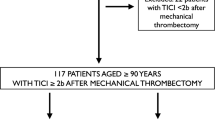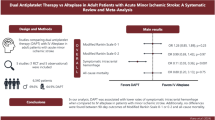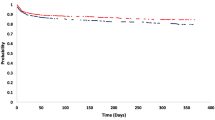Summary
Eighty-four patients aged less than 71 years with less than 4-hour duration acute myocardial infarction (AMI) were randomized in a multicenter study to 30 U anistreplase or heparin (single injection of 6500 IU followed by 1000 IU/hr). Early reperfusion was assessed from ECG changes (50% of sum ST decrease 2 hours postdosing) and the CK release profile (CK peak <16 hours after onset of symptoms, CK slope >10%hr). Reperfusion rates in patients meeting at least two criteria of reperfusion were 62.5% on anistreplase versus 27.5% on heparin. On delayed angiogram (13.7±3.4 days), patency rates were 66% with anistreplase versus 47% (NS) with heparin in 76 patients. Global LVF was similar in both groups. With anistreplase, the mean lowest fibrinogen level was 0.43±0.55 g/l, plasminogen was 20±9%, and the highest F.D.P. was 1447±548 μg/ml. All values recovered by hour 48. In-hospital and 1-year follow-up mortality was 7.2% (three patients) with anistreplase versus 10.2% (four patients) with heparin. Bleeding occurred in 9.7% and 5.1% of the patients (NS), respectively. No intracranial hemorrhage occurred. Thus, with combined clinical criteria or reperfusion, anistreplase is twice as efficient as heparin, has a good tolerance, and is easy to use as a single injection.
Similar content being viewed by others
References
Marder JV, Sherry S. Thrombolytic therapy: Current status (first of two parts).N Engl J Med 1988:318:1512–1520.
AIMS Trial Study Group. Effect of intravenous APSAC on mortality after acute myocardial infarction: Preliminary report of a placebo-controlled clinical trial.Lancet 1988;1:545–549.
Hillis WS, Hormung RS, Hogg KJ, Hockings N. Achievement of coronary artery patency by use of anisoylated plasminogen streptokinase activator complex in acute myocardial infarction.Drug 1987;Suppl 3:117–123.
Timmis AD, Griffin B, Crick JCP, et al. The effects of early coronary patency on the evolution of myocardial infarction: A prospective arteriographic study.Am Heart J 1987;58:345–351.
Shell W, Mickle DK, Swan HJC, et al. The effects of non surgical myocardial reperfusion on plasma creatine kinase kinetics in man.Am Heart J 1983;106:665–669.
The ISAM Study Group. A prospective trial of intravenous streptokinase in acute myocardial infarction (ISAM).N Engl J Med 1986;314:1465–1474.
Lewis BS, Ganz W, Laramec P, et al. Usefulness of a rapid initial increase in plasma creatine kinase activity as a marker of reperfusion during thrombolytic therapy for acute myocardial infarction.Am J Cardiol 1988;62:20–24.
Clauss A. Gerinnungsphysiologische schnellmethode für bestimmung des fibrinogens.Acta Haematol 1957;17:237–246.
The TIMI Research Group. Immediate versus delayed catheterization and angioplasty following thrombolytic therapy for acute myocardial infarction. TIMI II A results.JAMA 1988;260:2849–2958.
The TIMI Study Group. Comparison of invasive and conservative strategies after treatment with intravenous tissue plasminogen activator in acute myocardial infarction.N Engl J Med 1989;320:618–627.
Simoons ML, Betriu A, Col J, et al. Thrombolysis with tissue plasminogen activator in acute myocardial infarction: No additional benefit from immediate percutaneous coronary angioplasty.Lancet 1988;1:197–207.
Hogg KJ, Hornung RS, Howie CA, et al. Electrocardiographic prediction of coronary artery patency after thrombolytic treatment in acute myocardial infarction: Use of ST segment as a non-invasive marker.B Heart J 1988;60:275–280.
Hackworthy RA, Sorensen SG, Fitzpatrick PG, et al. Effects of reperfusion on electrocardiographic and enzymatic infarct size: Results of a randomized multicenter study of intravenous anisoylated plasminogen streptokinase activator complex versus intracoronary streptokinase in acute myocardial infarction.Am Heart J 1988;116:903–914.
Kennedy JW, Martin GV, Davis KB, et al. The western Washington intravenous streptokinase in acute myocardial infarction randomized trial.Circulation 1988;77:345–352.
Krucoff MW, Green CE, Lowell FS, et al. Non-invasive detection of coronary artery patency using continous ST segment monitoring.Am J Cardiol 1986;57:916–922.
Kircher BJ, Topol EJ, O'Neill WW, Pitt B. Prediction of infarct coronary artery recanalization after intravenous thrombolytic therapy.Am J Cardiol 1987;59:513–515.
Buckingham TA, Devine JE, Redd TM, Kennedy HL. Reperfusion arrhythmias during coronary reperfusion therapy in man. Clinical and angiographic correlations.Chest 1986; 90:346–351.
Cercek B, Horvat M. Arrhythmias with brief intravenous streptokinase infusion in acute myocardial infarction.Eur Heart J 1985;6:109–113.
Miller FC, Krucoff MW, Satler, LF, et al. Ventricular arrhythmias during reperfusion.Am J Cardiol 1986;112:928–932.
Goldberg S, Greenspan AJ, Urban PL, et al. Reperfusion arrhythmias: A marker of restoration of blood flow during intracoronary thrombolysis for acute myocardial infarction.Am J Heart 1983;105:26–31.
Nidorf SM, Thompson PL, de Klerk NH, et al. Prognostic significance of an early rise to peak creatine kinase after acute myocardial infarction.Am J Cardiol 1988;61:1178–1180.
Ganz W, Ninomiya K, Hashida J, et al. Intracoronary thrombolysis in acute myocardial infaction: Experimental background and clinical experience.Am Heart J 1981; 102:1145–1149.
Seabra-Gomes R, Aniceto Silva J, Aleixo A, et al. Evaluation of two intravenous thrombolytic agents (anisoylated plasminogen streptokinase activator complex versus streptokinase) in patients with acute myocardial infarction.Drug 1987;Suppl 3:169–174.
Meinertz T, Kasper W. Randomized multicentre trial of anisoylated plasminogen streptokinase activator complex versus heparin.Drugs 1987;Suppl 3:223–226.
Ganz W, Geft I, Shah PK, et al. Intravenous streptokinase in evolving acute myocardial infarction.Am J Cardiol 1984;53:1209–1216.
Hellstern P, Doenecke P, Könler M, et al. Intravenous bolus application of streptokinase and of anisoylated plasminogen streptokinase activator complex in acute myocardial infarction: Clinical and hemostaseological findings.Drug 1987; Suppl 3:183–185.
Cox DA, Sone PH, Muller JE, et al. Prognostic implications of an early peak in plasma MB creatine kinase in patients with acute AMI.J Am Coll Cardiol 1987;10:979–990.
Legeais S, Louvard Y. Pic précoce de créatine-kinase dans l'infarctus du myocarde non thrombolysé: Facteur pronostic?Arch Mal Coeur 1988;81:1345–1352.
Anderson JL, Rothbard TL, Hackworthy RA, et al. Multicenter reperfusion trial of intravenous anisoylated plasminogen streptokinase activator complex (APSAC) in acute myocardial infarction: Controlled comparision with intracoronary streptokinase.J Am Coll Cardiol 1988;11:1153–1163.
Bonnier AJRM, Visser RF, Klomps HC, et al. Comparison of intravenous anisoylated plasminogen activator complex and intracoronary streptokinase in acute myocardial infarction.Am J Cardiol 1988;62:25–30.
Timmis AD, Griffin B, Crick JCP, Sawton E. Anisoylated plasminogen activator complex in acute myocardial infarction. A placebo-controlled arteriographic coronary recanalization study.J Am Coll Cardiol 1987;10:205–210.
Tayemans Y, Materne P. Assessment of left ventricular function in a randomized study of anisoylated plasminogen streptokinase activator complex versus heparin in acute myocardial infarction: Preliminary results of the European multicentre study (Belgian centres).Drugs 1987;Suppl 3: 117–123.
Topol EJ, Califf RM, George BS, et al. Coronary arterial thombolysis with combined infusion of recombinant tissue type plasminogen activator and urokinase in patients with acute myocardial infarction.Circulation 1988;77:1100–1107.
Topol EJ, George BS, Kereiakes DJ, et al. Comparison of two dose regimens of intravenous tissue plasminogen activator for acute myocardial infarction.Am J Cardiol 1988;61:723–728.
Olson HG, Butman SM, Piters KM, et al. A randomized controlled trial of intravenous streptokinase in evolving acute myocardial infarction.Am Heart J 1986;111:1021–1029.
MacLennan BA, MacMaster A, Webb SW, et al. High dose intravenous streptokinase in acute myocardial infarction. Short and long term prognosis.Br Heart J 1986;55:231–239.
Schreiber TL, Miller DH, Silvoss DA, et al. Randomized double-blind trial of intravenous streptokinase for acute myocardial infarction.Am J Cardiol 1986;58:47–52.
Gruppo Italiano per lo Studio della Streptochinasi nell'Infarto Miocardio. Effectiveness of intravenous thrombolytic treatment in acute myocardial infarction.Lancet 1986;1:397–401.
Wilcox RG, Olson CG, Skene AM, et al. Trial of tissue plasminogen activator for mortality reduction in acute myocardial infarction. Anglo-Scandinavian Study of Early Thrombolysis (ASSET).Lancet 1988;2:525–530.
ISIS 2 Collaborative Group. Randomized trial of intravenous streptokinase, oral aspirin, or both, or neither among 17,787 cases of suspected acute myocardial infarction: ISIS 2.Lancet 1988;2:349–360.
Author information
Authors and Affiliations
Additional information
Anistreplase is the generic name ofEminase, a registered trademark of Beecham Pharmaceuticals.
Rights and permissions
About this article
Cite this article
Lardoux, H., Louvard, Y., de Vernejoul, D. et al. French multicenter trial of anistreplase versus heparin in acute myocardial infarction. Cardiovasc Drug Ther 4, 1337–1344 (1990). https://doi.org/10.1007/BF02018261
Issue Date:
DOI: https://doi.org/10.1007/BF02018261




